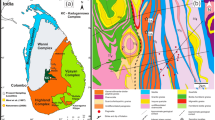Abstract
Medium grade metapelites of the Torrox unit (Betic-Rif Belt, S Spain) contain mineral assemblages consisting of garnet (Grt), staurolite (St), cordierite (Crd), biotite, kyanite, sillimanite, andalusite, muscovite (Ms) and quartz (Qtz) and record complex reaction processes of cordierite growth through garnet and staurolite decomposition. The reaction textures, the chemical composition of the reactant and product phases, including Fe-Mg-Mn partitioning, and the results of equilibrium thermodynamic calculations indicate that these cordierite-bearing assemblages are largely deviated from equilibrium. Furthermore, the actual cordierite-forming reactions, as estimated from the assemblage and associated textures, conflict with the predictions of thermodynamically based petrogenetic grids for the model pelite system KFMASH, either those that predict the stable coexistence of cordierite + muscovite plus garnet or staurolite or those that do not foresee a field of stability for these types of assemblages. This conflict is explained in terms of cordierite growth (at ca. 575 °C and 2.5 kbar) through metastable reactions whose operation was conditioned by the relict persistence of higher pressure phases (garnet and staurolite) and phase compositions (e.g. muscovite and biotite) after fast decompression. This interpretation militates against the existence of a wide P-T range of stable coexistence at low P of Crd + Ms + Qtz ± Grt ± St in medium grade metapelites of normal composition (i.e. poor in Zn and/or Mn). The triggering of metastable cordierite-forming reactions and the preservation of even subtle disequilibrium features associated to them indicate that the rocks underwent fast near-isothermal decompression from ca. 12 kbar down to 2–3 kbar, then rapid cooling. These inferences agree with independent evidence indicating that termination of alpine metamorphism in the western Betic-Rif Belt was related to the extensional collapse of thickened crust and that the latter had consisted of a single, continuous event.
Similar content being viewed by others
Author information
Authors and Affiliations
Additional information
Received: 6 August 1998 / Accepted: 9 February 1999
Rights and permissions
About this article
Cite this article
García-Casco, A., Torres-Roldán, R. Natural metastable reactions involving garnet, staurolite and cordierite: implications for petrogenetic grids and the extensional collapse of the Betic-Rif Belt. Contrib Mineral Petrol 136, 131–153 (1999). https://doi.org/10.1007/s004100050528
Issue Date:
DOI: https://doi.org/10.1007/s004100050528



